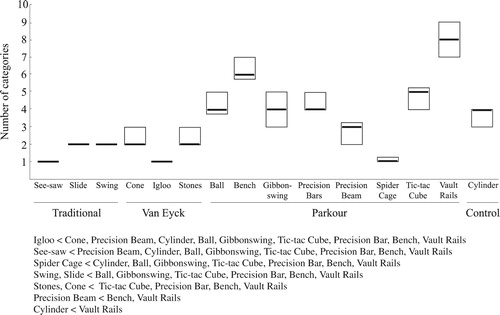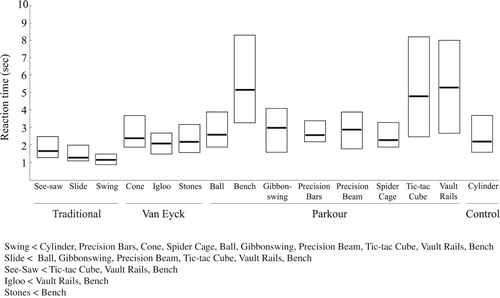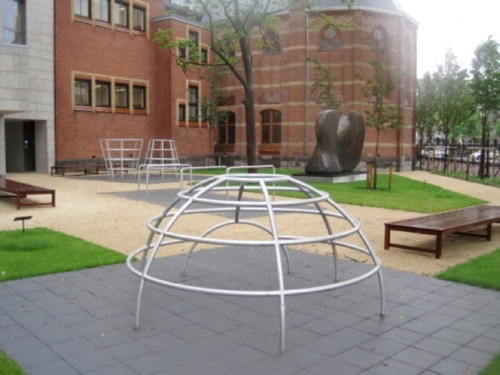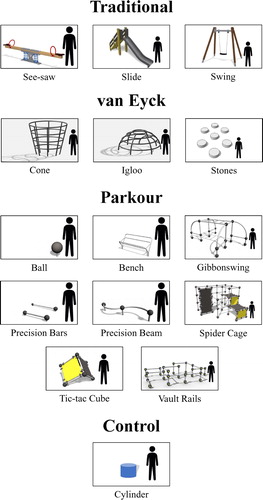ABSTRACT
The concept of open functions was introduced to capture an intended feature of van Eyck’s seminal play sculptures – they do not suggest a specific action. In a recent study, Van der Schaaf, A. L., S. R. Caljouw, and R. Withagen. (2020. “Are Children Attracted to Play Elements with an Open Function?” Ecological Psychology 32: 79–94) aimed to determine the degree of openness of Parkour play elements by asking participants what behavior children will mainly perform on them. In the present study, we used this method to determine the degree of openness of traditional play elements (e.g. a slide), van Eyck’s play sculptures, and Parkour play elements. In addition, we measured the time participants needed to answer the question of what action children will mainly perform on the different elements. We found that generally the Parkour elements have the highest degree of openness. Interestingly, van Eyck’s play elements appeared not to be that open. Moreover, the reaction time proved to be an alternative measure for the degree of openness.
Introduction
In the summer of 2002, the Stedelijk Museum Amsterdam put together an exhibition of Aldo van Eyck’s playgrounds. In the decades that followed the Second World War, van Eyck designed more than 700 playgrounds in Amsterdam, trying to give the city back to the children. Inspired by, among other things, the powerful sculptures of Constantin Brancusi, van Eyck designed a collection of abstract play elements that were supposed to stimulate the creativity of children (see ). Whereas most play equipment is designed with a specific action in mind (e.g. a slide is made for sliding), van Eyck did not do that – he aimed to design ‘tools for imagination’ (De Roode Citation2002). Indeed, in the foreword of the book that was made in the context of the exhibition, the art historian Fuchs suggested that van Eyck’s play sculptures have an ‘open function’ (Citation2002, 7): they do not suggest an action.
Recently, Withagen and Caljouw (Citation2017; see also Van der Schaaf, Caljouw, and Withagen Citation2020) aimed to understand these ‘open functions’ from a sociocultural perspective on affordances (e.g. Costall Citation1995, Citation2015; Rietveld and Kiverstein Citation2014). The concept of affordances was introduced by the ecological psychologist Gibson (Citation1979/1986) to refer to the action possibilities in the environment. Ever since Heft’s (Citation1988) seminal paper on the affordances in children’s environments, several authors have used the concept of affordances to understand the (play) behavior of children in rural and urban environments (Kyttä Citation2002, Citation2004; Sandseter Citation2009; Storli and Hagen Citation2010). Crucially, Gibson emphasized that any object generally affords several actions for an animal. For example, one can sit on a chair, but one can also stand on it, throw it in the air, cut it in pieces, and so on. Cutting (Citation1982) once enumerated over 30 affordances of a single piece of paper, and stressed that he could have easily extended the list. However, many objects tend to be used in a specific way in our society. Although a chair has many affordances for a human-being, it is for sitting on – that is the action it is made for (Costall Citation2015). In developing his sociocultural perspective on affordances, Costall (Citation1995) stressed the developmental aspects of the socializing process. Following the insights of Leont’ev (Citation1981), Costall emphasized that children are introduced to objects by the parents or guardians – they explain their children how, for example, a swing ought to be used, and by doing so they explain their children what the function of the swing is. Costall (Citation2015) called such a function the ‘canonical affordance’ of the object, to refer to its ‘single, definitive meaning’ (51) within a social practice.
By not designing the play elements with a specific action in mind, van Eyck’s play elements (contrary to see-saws, slides and swings) arguably escape from this normative framework. At first sight, it is hard to conceive of an action (apart from damaging it) that is not in accordance with the function of the play element. Indeed, by using abstract forms, van Eyck tried to design equipment that does not even suggest an action. As Van Lingen and Kollarova (Citation2016) put it, ‘Aldo van Eyck’s designs don’t aim to show what they are and how they should be used, they rather suggest what they could be’ (48).
Recently, a Parkour playground was introduced that is in keeping with this idea of open functions (see ). Like van Eyck’s play equipment, the elements of this playground have geometrical forms that also seem not to suggest a specific action, although the elements might vary in the degree to which they do so. As part of a bigger research project, Van der Schaaf, Caljouw, and Withagen (Citation2020) recently tried to measure the degree to which these Parkour play elements have an open function. Making the first steps in measuring the degree of openness, they argued that it should be conceived of as a feature of the play element (within a certain sociocultural setting) that is likely to shape the play behavior but that cannot be determined by it. Indeed, the fact that a play element does not suggest an action does not necessarily entail that children will also use it in multiple ways. Perhaps children need some suggestion on what to do with an object before they engage with it. Conversely, if an element clearly suggests an action (that is, the object does not have an open function), it also allows the children to break the rules, that is, to misuse it. Hence, it affords the children to be naughty (e.g. Costall Citation1995) which might mean that the object will be used in multiple ways.
Following the sociocultural perspective on affordances, Van der Schaaf, Caljouw, and Withagen (Citation2020) argued that the degree of openness of play elements should be determined on how these elements are perceived within society. And because, as we have argued above, adults significantly determine how objects are perceived by children because they raise them, Van der Schaaf, Caljouw, and Withagen (Citation2020) decided to provide adults with pictures of play elements and asked them what action children will mainly perform on them. The idea behind this method was that play elements with an open function will give rise to more different answers than elements with a less open function. After all, if an element (e.g. a swing) suggests a certain action, many participants are likely to give the same answer (e.g. swinging). If the function of the element is less clear (and thus more open), a wider variety of answers is to be expected. Because different participants might have used different terms to refer to the same action (e.g. climbing and clambering), other participants were to group the used terms together if they referred to the same action. The ensuing number of action categories arguably provided a better indication of the degree of openness than the number of different terms that were used.
Van der Schaaf, Caljouw, and Withagen (Citation2020) found that the number of action categories was significantly higher for elements like the cube and the ball than for the big frame that was in the back of . This not only suggested that the elements indeed vary in their degree of openness, but also provided evidence for the face validity of their method – of all the examined Parkour elements, the big frame in the back was, to their minds, the one that most clearly suggested an action (i.e. climbing). Interestingly, when Van der Schaaf, Caljouw, and Withagen (Citation2020) took the questionnaire, they noticed that participants generally needed more time to formulate the answer for elements like the cube and the ball than for elements like the climbing frame. Apparently, when the element more clearly suggests an action, it takes less time to name the action that will be mainly performed on this element than when the function of the element is more open. This indicates that reaction time might be an alternative measure of the degree of openness of play elements. And since we are at the beginning of operationalizing the concept of open function, this would be an interesting finding.
The purpose of the present study is two-fold. First, we will test the degree to which the Parkour play elements, Aldo van Eyck’s play sculptures, and traditional play elements have an open function. To that end, we replicate Van der Schaaf, Caljouw, and Withagen’s (Citation2020) experiment in which participants have to mention the action that children will mainly perform on a play element, but now using pictures of all of these play elements. Which of the elements have the highest degree of open function? And did Aldo van Eyck succeed in designing elements that do not suggest an action? Moreover, in the present study we will also measure the time it takes the participant to formulate the answer. If we find a correlation between the number of action categories for each element and the reaction time, the latter might be an alternative measure of openness.
Method
Participants
Twenty participants (13 female and 7 male; mean age 21.6 ± 2.1 years) were to name what action children will mainly perform on the different elements. In addition, and in line with the earlier study by Van der Schaaf, Caljouw, and Withagen (Citation2020), another group of participants was asked to group the used terms together if they, in their view, refer to the same action. This second group consisted of twenty-two participants (12 female and 10 male; mean age 22.1 ± 3.1 years) The study was approved by the local institution's ethics committee. All participants gave their informed consent.
Procedure
To determine the degree to which a play element has an open function, we used a similar method as Van der Schaaf, Caljouw, and Withagen (Citation2020) did. However, instead of taking a paper questionnaire with pictures of the play elements, participants were to sit behind a computer screen that showed pictures of 15 different play elements: eight Parkour play elements, three play sculptures of Aldo van Eyck, three traditional play elements, and, as a control, one cylinder that was not specifically designed for playing (see ). Next to the picture of the play element, an image of a child (1.45 meter tall) was depicted to give an indication of the size of the play element. The 15 pictures were shown one by one and the order was randomized for each participant. The participants were to say out loud the action they think children will mainly perform on the play element that was being presented to them on the screen. They were instructed not to formulate a sentence (‘I think that children will mainly slide on this element’), but to simply mention one action (e.g. ‘sliding’). The participants were not informed that we measured reaction time. They were informed that they could mention the same action for different play elements. After they mentioned the action, the participants could press the space bar of the laptop to go to the next play element. To determine the time a participant needed to formulate an answer, the presentation of each playing element was accompanied by a sound signal (a short beep). With a video camera (GoPro Hero 4 Silver) we recorded the participant’s answer for each play element with 60 frames per second. Based on these recordings, both the participants’ answers and their reaction times were determined.
Analysis
Of the twenty participants who were to name the action that children will mainly perform on each element, one was excluded from data analysis. Despite the instruction not to formulate a sentence, this participant did do so on one occasion, rendering it impossible to compare his reaction times for the different elements.
To determine how many different actions were mentioned for each play element, we presented the other participants with a picture of each play element and cards with the different terms that were used to describe what action children will mainly perform on that element. The participants were instructed to group terms together if they, in their view, referred to the same action. To that end, they were to put a card on top of the other card(s) that referred to the same action (cf. Van der Schaaf, Caljouw, and Withagen Citation2020). The play elements were presented one by one and the order was randomized for each participant. The number of piles, that is, the number of action categories that each participant had made, was used in the ensuing analysis as a measure of openness.
We used The Observer XT 11.5 (Noldus Information Technology, Wageningen, the Netherlands) to determine the reaction times of the participants. Using the sound signals, we determined the time between the beep that accompanied the presentation of the picture of the play elements and the onset of the participant’s uttering of the action term. Sounds that reflected thinking (like eh) were ignored.
Results
We first tested whether the different play elements vary in the degree of openness using the method of Van der Schaaf, Caljouw, and Withagen (Citation2020). presents the median (and the 25th and 75th percentiles) of the number of action categories that were made by the second group of participants. A Friedman test on the number of action categories made per element was significant (χ2(14) = 269.88, p < .001, Kendall’s W = .88). The results of Siegel and Castellan’s (Citation1988) post hoc test are depicted below the figure. We found that all of the traditional play elements (Swing, See-saw, and Slide) have a lower degree of openness than the majority of the Parkour play elements (the Ball, Gibbonswing, Tic-tac Cube, Precision Bars, Bench, and Vault Rails) – for the See-saw we found also a significant difference with the Precision Beam. No significant differences were observed between the Spider Cage and the traditional play elements. Interestingly, we found no significant differences between van Eyck’s sculptures and the traditional play elements. Apparently, van Eyck did not succeed in designing elements that outperform the Swing, the See-saw, and the Slide in terms of openness. Relatedly, we found that van Eyck’s play sculptures were less open than some of the Parkour play elements (minimally the Tic-tac Cube, Precision Bars, Bench, and Vault Rails).
Figure 4. The median and the 25th and 75th percentiles of the number of action categories for each play element. The top of the bars indicates the 75th percentiles, the bottom of the bars indicates the 25th percentiles, and the thick line in the bars indicates the medians. Significant differences are mentioned below the figure.

Subsequently, we compared the participants’ reaction times for the different elements. The median (and the 25th and 75th percentiles) of the reaction time for each element is depicted in . Because the reaction times were not normally distributed, we opted for conducting a non-parametric repeated-measures ANOVA. The Friedman test on the reaction times was significant (χ2(14) = 109.99, p < .001, Kendall’s W = .46). Interestingly, the results of the post hoc test (Siegel and Castellan Citation1988) revealed a similar pattern as for the number of action categories – the reaction times for the traditional play elements were significantly shorter than for several or all of the Parkour elements. This effect was most pronounced for the Swing – we found significant differences between this traditional play element and all of the Parkour play elements. Comparing the traditional play elements and van Eyck’s play sculptures, we found that only the reaction time for the Swing was significantly shorter than for the Cone. And when it comes to a comparison between van Eyck’s play sculptures and the Parkour elements, we found differences between the Igloo and the Vault Rails and the Bench, and between the Stones and the Bench.
Figure 5. The median and the 25th and 75th percentiles of the reaction time for each play element. The top of the bars indicates the 75th percentiles, the bottom of the bars indicates the 25th percentiles, and the thick line in the bars indicates the medians. Significant differences are mentioned below the figure.

To determine whether reaction time is an alternative measure for openness, we computed a Spearman correlation between the median number of action categories and the median reaction time for each element. This correlation was strong and significant (r = .812, p < .001), indicating that if the function of an element is less clear (i.e. more different actions were mentioned by different participants), it takes an individual participant longer time to formulate an answer.
Discussion
In the present study we tested the degree to which traditional play elements, Parkour play elements, and van Eyck’s play sculptures have an open function. To that end, we used the method of Van der Schaaf, Caljouw, and Withagen (Citation2020) – we asked participants to name the action that children will mainly perform on each of the play elements. The idea of this method is that if an element is more open (i.e. does not suggest an action), participants will give different answers. Conversely, if the element has a clear function (i.e. it does suggest an action), participants are likely to give the same answer. In addition, we now also measured the time it takes a participant to formulate an answer.
We found that the Parkour elements had the highest degree of openness – the number of actions that were mentioned for the majority of these elements was significantly higher than for both the traditional play elements and van Eyck’s play sculptures. Hence, the suggestion on what to do with a piece of play equipment was the weakest for these Parkour elements. However, arguably the most interesting finding of the present experiment, is that van Eyck’s play sculptures did not differ from the Swing, the Slide, and the See-saw in their degree of openness. This finding might not simply be the result of the (bad) design of van Eyck’s play elements but arguably has more to do with the social embeddedness of some of his elements. As argued in the introduction, the sociocultural perspective on affordances stressed that children grow up in an environment in which many objects already have their definite meaning. And they are introduced to the meaning of these objects by the parents and guardians. Hence, although each and every play element affords many activities, there is generally a conventional way of using it.
Of van Eyck’s play elements, especially the Igloo and the Stones have been frequently installed in many Dutch playgrounds over the last decades. And although these elements might have been open in the years after introduction, they arguably have lost their openness in time because they became part of social practices. Indeed, children might have used these elements primarily for certain actions over a considerable period of time, perhaps also with parents explaining their offspring on how to use these pieces of equipment. As a result, these elements have gained a more definitive meaning – the Igloo became a climbing frame. And in a way, in this process the object has lost many of its affordances. This would also explain why the recently new Parkour elements have the highest degree of openness – a conventional way of using these elements has not yet emerged. That is, the degree to which a play element is open is not simply the result of the design of the element but depends to a large extent on the social practices in which it takes part.
Another interesting finding was that the time it takes an individual participant to name the action that children will mainly perform on a particular element was highly correlated with the number of different actions that were mentioned for that element. This means that reaction time is an alternative measure for the degree of openness – if the function of the element is less clear, it takes participants longer to formulate the answer. We consider this finding to be significant, primarily because we are at the beginning of operationalizing the concept of open functions. As mentioned in the introduction, this concept was introduced by the art historian Fuchs in 2002, but to our knowledge, Van der Schaaf, Caljouw, and Withagen (Citation2020) was the first to determine the degree to which play elements have such an open function. The fact that reaction time correlates strongly with the number of actions mentioned means that we get a firmer grip on how to determine the degree of openness. And this allows us to make the next step and start examining how openness shapes play behavior. Do play elements that do not suggest a certain behavior indeed stimulate the creativity of children as van Eyck suggested? Are open elements indeed used in different ways? Or do children need some suggestion on what to do with an object before they actively engage with its affordances? Based on the study by Van der Schaaf, Caljouw, and Withagen (Citation2020), we know that children are more attracted to Parkour play elements with a less open function than to Parkour elements with a more open function. But how the open elements shape play behavior still needs to be studied.
Acknowledgements
We would like to thank Rineke Baas, Tessa van Tilburg, Carlijn de Vries, and Julius op de Weegh for assistance with running the experiment. Bert Otten is gratefully acknowledged for making pictures of Aldo van Eyck’s Igloo and Cone. We thank the editor and two anonymous reviewers for very helpful comments on an earlier version of this paper.
Disclosure statement
No potential conflict of interest was reported by the author(s).
References
- Costall, A. 1995. “Socializing Affordances.” Theory & Psychology 5: 467–481.
- Costall, A. 2015. “Canonical Affordances and Creative Agency.” In Rethinking Creativity: Contributions for Social and Cultural Psychology, edited by V. P. Glaveanu, A. Gillespie, and J. Valsiner, 45–57. New York: Routledge.
- Cutting, J. E. 1982. “Two Ecological Perspectives: Gibson vs. Turvey and Shaw.” The American Journal of Psychology 95: 199–222.
- De Roode, I. 2002. “The Play Objects: More Durable Than Snow.” In Aldo van Eyck: The Playgrounds and the City, edited by L. Lefaivre, and I. de Roode, 84–101. Rotterdam: NAi Publishers.
- Fuchs, R. 2002. “Foreword.” In Aldo van Eyck: The Playgrounds and the City, edited by L. Lefaivre, and I. de Roode, 7. Rotterdam: NAi Publishers.
- Gibson, J. J. 1979/1986. The Ecological Approach to Visual Perception. Boston: Houghton, Mifflin and Company.
- Heft, H. 1988. “Affordances of Children’s Environments: A Functional Approach to Environmental Description.” Children’s Environments Quarterly 5: 29–37.
- Kyttä, M. 2002. “Affordance of Children’s Environments in the Context of Cities, Small Towns, Suburbs and Rural Villages in Finland and Belarus.” Journal of Environmental Psychology 22: 109–123.
- Kyttä, M. 2004. “The Extent of Children’s Independent Mobility and the Number of Actualized Affordances as Criteria for Child-Friendly Environments.” Journal of Environmental Psychology 24: 179–198.
- Leont’ev, A. N. 1981. Problems of the Development of the Mind. Moscow: Progress Publishers.
- Rietveld, E., and J. Kiverstein. 2014. “A Rich Landscape of Affordances.” Ecological Psychology 26: 325–352.
- Sandseter, E. B. H. 2009. “Affordances for Risky Play in Preschool: The Importance of Features in the Play Environment.” Early Childhood Education Journal 36: 439–446.
- Siegel, S., and N. J. Castellan. 1988. Nonparametric Statistics for the Behavioral Sciences. 2nd ed. New York: McGraw-Hill.
- Storli, R., and T. L. Hagen. 2010. “Affordances in Outdoor Environments and Children’s Physically Active Play in pre-School.” European Early Childhood Education Research Journal 18: 445–456.
- Van der Schaaf, A. L., S. R. Caljouw, and R. Withagen. 2020. “Are Children Attracted to Play Elements with an Open Function?” Ecological Psychology 32: 79–94.
- Van Lingen, A., and D. Kollarova. 2016. Aldo van Eyck: Seventeen Playgrounds. Eindhoven: Lecturis.
- Withagen, R., and S. R. Caljouw. 2017. “Aldo van Eyck’s Playgrounds: Aesthetics, Affordances, and Creativity.” Frontiers in Psychology 8: 1130.



